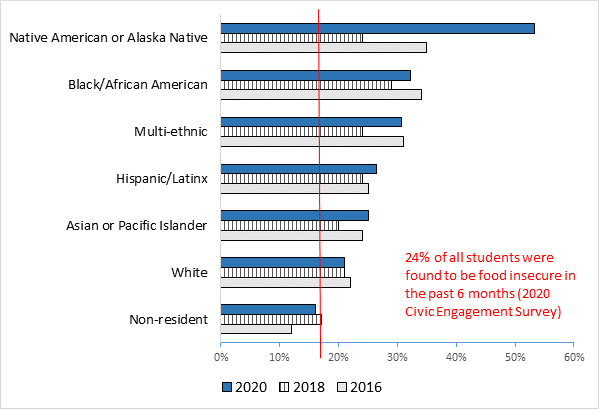“I’ve never seen so many students in need”
“The last five years have been pretty intense when it comes to financial stress to students,” explained Sandra Rodriguez, the director at the Center for Student Engagement. Back in 2009, amidst one of the worst economic recessions, the Associated Students of the University of Nevada (ASUN) began noticing students dropping out of school and they wanted to find a solution.
The president of the student body government created a fund to help students overcome periods of financial and/or emotional duress. Money was placed into a special account dedicated to assisting students who were struggling to make ends meet.
The former Associate Vice President of Student Life, Gerald Marczynski oversaw the fund, giving it its name. Along with his wife, Cynthia Marcyznski, the Director of the Counseling Center, the duo “were amazing about helping out students in need,” said Rodriguez. They helped students through trials of food insecurity, mental health troubles, and financial insecurity. Flash forward ten years and both Marczynskis retired in the summer of 2019. This was when the ASUN decided to make a greater effort to expand the fund and it formally became the Marczynski Student Emergency Fund.
“As the cost of higher education goes up, I’ve never seen so many students in need,” Rodriguez said. She has over 30 years of experience working with students in higher education. She emphasized the needs are legitimate; things like housing, food, glasses, and prescriptions are all being requested. These are the tools helping students succeed in their academic endeavors. Since last year, the fund has grown immensely and she says has been a lifeline for many students in need.
Results from the past three Civic Engagement Surveys at UNR show food insecurity by ethnicity; people of color are most affected over the past four years. Graphic shared by Center for Student Engagement with permission to use in this article.
A Quarter of Students Face Food Insecurity
“As of this last week, we’ve already had 90 applications for that account,” said Rodriguez, referring to the first week of the Spring semester. The pandemic has placed a seemingly boundless amount of stress on students. Every two years the university conducts a Civic Engagement Survey and last year, nearly 4000 students responded. The past three surveys, 2016, 2018, and 2020 have shown that nearly a quarter of students face food insecurity.
Furthermore, students of color are more likely to be food insecure and face financial duress, compared to white students. As of the fall 2020 survey, 30% of students were uncertain that they could pay for tuition and fees for the current semester. Because of this the ASUN has also boosted both its Pack Provisions food pantry program and the Marczynski Student Emergency Fund. They have also begun targeting groups more likely to face financial and food insecurities.
As the reach of the pandemic widens, the emergency fund is being put to the test. Rodriguez explained that any university student experiencing an emergency can apply for this fund. It begins with a quick survey found here. Once students fill out the short form they will be contacted within 24 to 48 hours for an expansive face-to-face, COVID safe interview by a member of the Dean of Students Office.
“They work with the student to try and not only bridge the gap but then to connect them to resources that will help them get through the entire semester and get them back on track,” said Rodriguez. The assistant dean will look over the student’s work and seek to clearly understand the underlying problem for the student.
There is a level of intense intervention that goes into play along with the funding. Counselors will look at all resources available to the student for ways to boost their success. Is there financial aid available? Are there campus jobs?
“How successful is a student going to be if they can’t have the books they need to go to class,” questioned Rodrigeuz. The Dean of Students knows these emergencies can be the hair on the camel’s back for students. It becomes a choice of paying for tuition or eating. “That’s the value of the intrusive discussion between the Assistant Dean and the student in need,” said Rodriguez. Usually the need for financial assistance is immediate and because of this the turnaround time for receiving aid is oftentimes less than three days, rarely a full business week. In addition, during the application process, the Dean of Students will reach out to the involved parties to let them know of pending assistance.
Funding the Fund
The initial annual allotment of funds comes from the student government body and is around $43,000. As of December 2020, the ASUN was able to place another $57,000 in the fund. Money that would have gone towards various programming in a non-pandemic world, was redirected into relief funds, including the Marczynski Student Emergency Fund. Alumni Relations and Institutional Advancement also help run a fundraiser campaign every year to increase the fund’s value.
“It is just amazing how generous the community has been,” said Rodriguez “in particular we’ve also had businesses who have found out about this campaign.” This campaign is currently underway and can be found here. At the time of our interview, the fundraiser had brought in almost $22,000. Rodriguez went on to explain that many donations have been between one and two thousand dollars. She explained there was no way ASUN could have kept up with the increased need the pandemic created.
“You never know when we’re gonna find ourselves in need,” said Rodriguez. “I just really want the community to know of the existence of this fund and the fact that it’s named after two people who devoted 40 years in higher education to helping students in need, the fund exists, it is in place here to get the students through a rough patch.”
Reporting by Richard Bednarski for Our Town Reno
sign up to our free weekly newsletter here: https://ourtownreno.substack.com/


